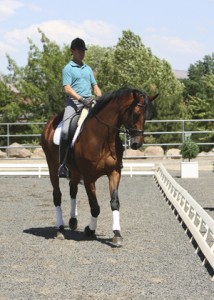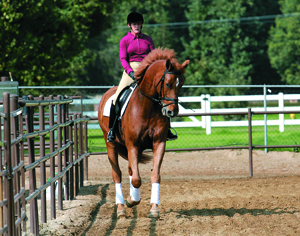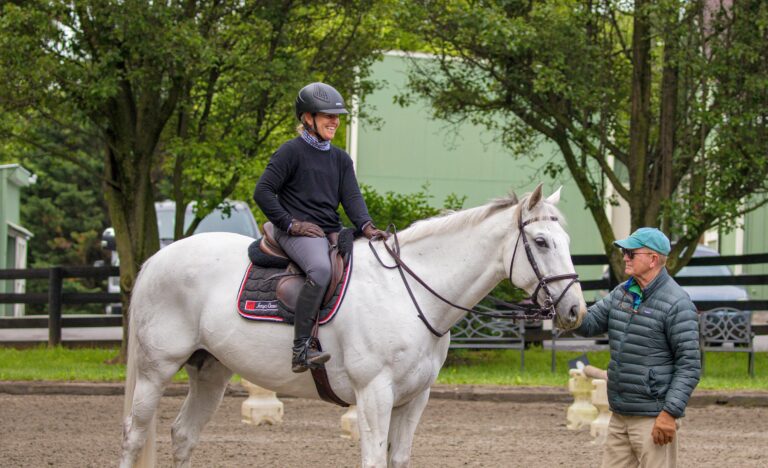One of the greatest mysteries about training horses is how they come to accept us and to put their incredible grace and power at our disposal. This miracle does not happen easily, of course. While it takes years of patient, consistent, methodical horse training techniques to produce such a horse, if we follow this approach, the mental, physical and, yes, competitive results are the psychic payoff that horsemen seek.
If I had to pick one thing that a trained horse can do that an untrained one cannot, I would say that the trained horse has learned to engage his hind leg in response to the rider’s leg aid. This engagement I speak of refers to your horse’s ability to step farther under his body with his hind legs and to bear a greater share of his weight with his hindquarters. This process does not happen overnight. It takes suppleness, muscular development and a trained, systematic response on the part of the horse. It also takes years of study, practice and improvement on the part of the rider, as well as endless patience.
Without the horse’s response to your leg aid, however, you will be unable to engage him; as long as you lack that ability, your horse will remain forever untrained.
Early Horsemen Who Got it Right
As with anything to do with the training of horses, I always review the source documents before I start writing my articles. Since the topic here is the engagement of the horse’s hind leg, we are basically talking about leg-yielding and shoulder-in, because these are the movements we use to teach the horse to step under his body with his hind leg.
To discuss these two movements correctly, I first needed to reread works by the two widely acknowledged inventors of these basic and necessary exercises: the Duke of Newcastle, who wrote A New Method, and Extraordinary Invention, to Dress Horses in 1667 and Francois Robichon de la Gueriniere, who published Elemens de Cavalerie in 1731.
The first thing I noticed about these two books is that they were written a long time ago. This just points out that super horsemen have been training and carefully watching horses for a long time now, and they wrote books about their experiences. Why should you read books like this? As Paul Belasik says in Exploring Dressage Technique, “Great riders have told you something. They thought it was important.” And so it is that you read and listen to these experts’ voices in your head, if you want to profit from their thoughts on the subject.
Later Horsemen Try to Reinvent It
As an aside, I am continually amused at the efforts of “natural horsemen” to avoid using historical terminology. I once watched a famous natural horseman spend half an hour with a young horse on a circle in front of a large audience, practicing leg-yielding. His work was very patient and correct, and the horse was responding calmly and well to the training. During the entire demonstration, which was quite good and nonconfrontational, this expert went to incredible lengths to avoid using any terminology that could even remotely imply that any other rider in the world had ever done what he was now demonstrating. “Friend,” I laughed to myself, “you are about 400 years late picking up lateral-leg response, but you are on the right track, keep it up.”
 Teach your horse leg-yielding with his head to the wall first. The wall substitutes for your hand to a certain degree. This allows you to concentrate on producing the leg-yielding with your leg rather than your hand. Volker Brommann and Farino are producing a very correct leg-yielding here. Notice the four separate and distinct tracks that Farino is moving on and that each of the tracks is parallel to the long side of the arena. Practice leg-yielding at the walk before you attempt it at the trot. Once your horse understands what you want, he will be able to deal with the added momentum of the trot.
Teach your horse leg-yielding with his head to the wall first. The wall substitutes for your hand to a certain degree. This allows you to concentrate on producing the leg-yielding with your leg rather than your hand. Volker Brommann and Farino are producing a very correct leg-yielding here. Notice the four separate and distinct tracks that Farino is moving on and that each of the tracks is parallel to the long side of the arena. Practice leg-yielding at the walk before you attempt it at the trot. Once your horse understands what you want, he will be able to deal with the added momentum of the trot. But while I was laughing at him, I was also laughing at myself.
When I was just getting started as an instructor, I secretly wanted to discover something new, something special that I could add to the total body of knowledge about training horses. While fooling with a young horse one winter day, I noticed that his canter depart improved if I practiced inside leg-yielding on a circle before I asked for a canter depart. “Huh,” I thought, “that’s interesting.” So I tried it on several horses and had good results with it. Fortunately, before I took out an advertisement bragging about this big new breakthrough in dressage, I read the Duke of Newcastle. You guessed it–right there in the text. I suppose the phrase “new method” in the title should have put me on notice. If it was a new method in 1667, it was old hat 300 years later. Live and learn.
Defining the Terms
Anyway, where was I? Oh, yeah, engaging the horse’s hind leg. From my own studies, it looks as if Newcastle did more of what we today would call “leg-yielding,” wherein the horse travels laterally on four separate tracks, while de la Gueriniere sought to put his horses on three tracks in shoulder-in (when viewed from behind, the tracks you see are outside hind, inside hind and outside fore, and inside fore.) Pure dressage experts can get into quite involved discussions about these two movements. However, I do not want to get into a “how-many-angels-can-dance-on-the-head-of-a pin” argument, so I am going to ignore that part of the dressage rodeo and talk to you about training horses in the real world.
As I said in the opening paragraphs, the simple truth is that if you cannot engage your horse, you cannot truly be said to be able to control him. Simple, just not easy.
OK, if engagement of your horse’s hind leg is so important, how should you go about it? In the interests of keeping it simple, let’s start by describing the process of engaging it. (Simple: There is an interesting concept so interesting, in fact, that Xenophon talked about it more than 2,400 years ago. “Teach the easy before the difficult,” he said. What a concept.)
Executing the Concept
To keep things simple, you need to begin with lateral work that comes before even leg-yield: Teach your horse “turn on the forehand.” For example, a turn on the forehand to the right means you halt and apply your left leg about 6 inches behind the girth. Done correctly, your horse should pivot on his right front foot, cross his left hind leg over and in front of his right hind leg, and turn 180 degrees. He won’t be very good at it at first, but he will get better with practice. Practice works for kissing, and it will work for turn on the forehand as well.
Make sure you practice turn on the forehand in both directions and that you notice whether your horse has an easy side and a difficult side. This is a valuable clue and one you will need to be aware of for years, until your horse one day becomes truly symmetrical.
Once your horse is confirmed in his response to your lower leg in the turn on the forehand, walk down the long side of an arena to the right. I am about to introduce you and your horse to leg-yielding, and it is easier to teach this with your horse’s head to the wall. The wall substitutes for your hands to a great extent, and any time we teach our horses something without using our hands is worthwhile. As you come out of the corner toward the long side of the arena, apply your left leg behind the girth. Your horse should move his hindquarters in off the wall and maintain the rhythm of the walk. Use a mirror to see your horse’s hoofprints, and try to keep him on four separate and distinct tracks.
Your leg will produce the required bend in your horse’s body, so think to yourself that you are riding a straight horse with a slight angle to the wall. Make sure you feel your horse seeking the opposite rein as you walk down the long side at the walk. Ask for a few steps, straighten down the long side and then repeat. It is better to ask for a few steps at a time rather than trying to continue down the entire long side the first time you attempt this movement.
Your terminology can get complicated if you let it, so simplify it as much as possible. For example, if you are proceeding at the walk and track to the right in left leg-yielding, have the feeling your horse is stepping into your right rein. Try not to use “inside rein-outside rein” in this context. In the movement described above, your horse is theoretically stepping into your “outside” rein, but it means outside the bend not outside the arena. Never mind. Ask your horse to step from one leg to the opposite rein. Think of “right” and “left,” not “inside” or “outside,” and it will keep things clear in your mind. Later on you will find yourself able to feel the outside rein even when it is inside the arena.
When you’re comfortable leg-yielding at the walk, practice it at the trot.
Advance to Shoulder-In
Once your horse is adept at turn on the forehand and leg-yielding, introduce him to shoulder-in at the walk. Don’t get nervous, just think of it at first as leg-yielding with your horse’s head to the inside of the arena. If you have been calm and methodical to this point, you should have no problems.
 Practice shoulder-in to establish the connection between your inside leg and your outside rein. When you have that connection, you have your horse between the accelerator and the brake, and your horse begins to place his grace and power at your disposal. You can see the engagement of Cassiano’s hind leg, and Leslie Webb has him moving on three tracks, which is correct for the shoulder-in.
Practice shoulder-in to establish the connection between your inside leg and your outside rein. When you have that connection, you have your horse between the accelerator and the brake, and your horse begins to place his grace and power at your disposal. You can see the engagement of Cassiano’s hind leg, and Leslie Webb has him moving on three tracks, which is correct for the shoulder-in.Once you have your horse established in inside leg-yielding, start paying more attention to the mirrors, if you have them. Gradually produce a movement that is a true shoulder-in. The big change you will make with your aids is to bring your inside leg closer to the girth. The effect will be to bring your horse’s shoulders closer to the track. This will gradually produce the three tracks that shoulder-in requires.
Just as it was with leg-yielding, the bend in your horse’s body should be produced by your leg, not by your hand. If you tend to pull on the reins, try taking your inside rein in a bicycle grip for a steadier feel.
During this introductory period, you will find it difficult to remain consistently on three tracks. One minute, you will be out too far; the next minute, you will lose your horse’s shoulder onto the track. This is a normal part of the training process, and you will improve it by consistently reminding your horse when he deviates and rewarding him for those brief steps of correct work. Keep in mind that the essential lesson your horse should learn from shoulder-in is that as a response to the inside leg, he should seek the outside rein.
It is a wonderful moment when horse and rider first become connected in this manner. Your horse has just made the first step toward placing his strength at your disposal. For the next year or more, work your horse in this connection, inside leg to outside rein. Work him on both hands, slightly accentuating the work on his weak side.
The simple reason this works is that when you ride your horse between your inside leg and your outside rein, you are riding him between the accelerator and the brakes. This magical, mysterious connection is what begins to place all of your horse’s grace and power at your subtle, nearly invisible control. De la Gueriniere once remarked about the shoulder-in, “I regard it as the alpha and omega of all exercises for the horse.”
And with the discovery of the inside leg-to-outside-rein connection, we arrive at the essence of de la Gueriniere genius, for this connection is the one true essential in the training of horses. He had the necessary feel and tact to notice that when the rider closes one leg, the horse steps to the opposite rein. And once we have this connection, we can truly be said to be training. Once we have this connection, we can engage our horses, and once we begin to engage our horses, the possibilities are endless.
This article originally appeared in the November 2010 issue of Practical Horseman.










